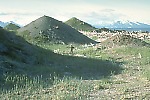Examples of Volcanic Landslides
Landslide at Mount St. Helens volcano leads to new interpretations
The landslide and eruption of Mount St. Helens on May 18, 1980, demonstrated how a volcano can collapse catastrophically, fill an adjacent river valley with rocks and debris, and generate a destructive lahar. With this unforgettable example in mind, scientists from around the world have taken a new look at the geologic record of other volcanoes in hopes of finding similar landslide deposits. They've found several hundred deposits, some more than 10 times larger than the 1980 landslide at Mount St. Helens!
It is clear from these new discoveries that volcano landslides occur far more frequently than had been recognized by scientists before the 1980 eruption of Mount St. Helens. More than 20 landslides >0.1 km3 have occurred in the past 500 years, most of them associated with either magmatic or phreatic explosive eruptions. Landslides are now widely considered as an important volcano hazard that must be taken into account when a hazard assessment is prepared.
Discovery of so many landslide deposits was made possible because of three characteristics that geologists can easily recognize in the field:
- hummocks or mounds that form the surface of many landslide deposits
- shattered but otherwise well-preserved volcanic rock layers within the deposit
- lahar deposits rich in hydrothermally-altered silt and clay particles and volcanic rocks downstream from a volcano
Examples of other volcano-landslide deposits
Mount Shasta, California
View looking south across hundreds of hummocks at the base of Mount Shasta volcano in northern California. This deposit is about ten times larger than the landslide that occurred at Mount St. Helens in 1980.View of internal rock layers and shear zones within a large hummock, Mount Shasta in distance; Interstate Highway 5 in foreground. The layers consist of volcanic rocks identical to rocks of Mount Shasta.
Augustine Volcano, Alaska
View looking across hummocks of a landslide deposit at the base of Augustine volcano, Alaska. Scientists have found at least 11 deposits that are less than 2,000 years in age!Close view of several hummocks from Augustine's largest known landslide deposit; for scale, note geologist in center of photograph.
Mount Egmont, New Zealand
View looking across hummocks of a landslide deposit at the base of Mount Taranaki (or Mount Egmont), an active volcano in New Zealand.References
Crandell, D.R., 1989, Gigantic debris avalanche of Pleistocene age from ancestral Mount Shasta volcano, California, and debris-avalanche hazard zonation: U.S. Geological Survey Bulletin 1861, 29 p.
Beget, J.E., and Kienle, J., 1992: Cyclic formation of debris avalanches at Mount St. Augustine volcano: Nature, v. 356, pp. 701-704.
Siebert, L., 1996, Hazards of large volcanic debris avalanches and associated eruptive phenomena, in Scarpa, R., and Tilling, R.I. (eds), Monitoring and mitigation of volcano hazards: Springer-Verlag, Berlin Heidelberg, pp. 541-572.
Siebert, L., 1984, Large volcanic debris avalanches: characteristics of source areas, deposits, and associated eruptions: Journal of Volcanology and Geothermal Research, v. 22, n. 3/4, pp. 163-197.










